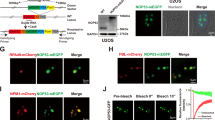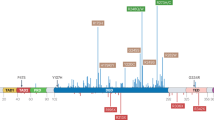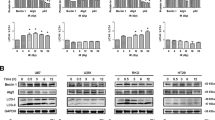Abstract
Nitric oxide (NO) is a potent activator of the p53 tumor suppressor protein. However, the mechanisms underlying p53 activation by NO have not been fully elucidated. We previously reported that a rapid downregulation of Mdm2 by NO may contribute to the early phase of p53 activation. Here we show that NO promotes p53 nuclear retention and inhibits Mdm2-mediated p53 nuclear export. NO induces phosphorylation of p53 on serine 15, which does not require ATM but rather appears to depend on the ATM-related ATR kinase. An ATR-kinase dead mutant or caffeine, which blocks the kinase activity of ATR, effectively abolishes the ability of NO to cause p53 nuclear retention, concomitant with its inhibition of p53 serine 15 phosphorylation. Of note, NO enhances markedly the ability of low-dose ionizing radiation to elicit apoptotic killing of neuroblastoma cells expressing cytoplasmic wild-type p53. These findings imply that, through augmenting p53 nuclear retention, NO can sensitize tumor cells to p53-dependent apoptosis. Thus, NO donors may potentially increase the efficacy of radiotherapy for treatment of certain types of cancer.
Similar content being viewed by others
Log in or create a free account to read this content
Gain free access to this article, as well as selected content from this journal and more on nature.com
or
Abbreviations
- NO:
-
nitric oxide
- NOS:
-
nitric oxide synthases
- NES:
-
nuclear export signal
- PARP:
-
Poly(ADP-Ribose) Polymerase 1
- NLS:
-
nuclear localization signals
- LMB:
-
lyptomycin B
References
Burney S, Caulfield JL, Niles JC, Wishnok JS and Tannenbaum SR (1999) The chemistry of DNA damage from nitric oxide and peroxynitrite. Mutat. Res. 424: 37–49
Hess DT, Matsumoto A, Nudelman R and Stamler JS (2001) S-nitrosylation: spectrum and specificity. Nat. Cell. Biol. 3: E46–E49
Brune B and von Knethen A (2002) The role of nitric oxide and cyclooxygenase-2 in attenuating apoptosis. J. Environ. Pathol. Toxicol. Oncol. 21: 103–112
Schmidt HH and Walter U (1994) NO at work. Cell 78: 919–925
Zweier JL, Samouilov A and Kuppusamy P (1999) Non-enzymatic nitric oxide synthesis in biological systems. Biochim. Biophys. Acta. 1411: 250–262
Melillo G, Musso T, Sica A, Taylor LS, Cox GW and Varesio L (1995) A hypoxia-responsive element mediates a novel pathway of activation of the inducible nitric oxide synthase promoter. J. Exp. Med. 182: 1683–1693
Melillo G, Taylor LS, Brooks A, Musso T, Cox GW and Varesio L (1997) Functional requirement of the hypoxia-responsive element in the activation of the inducible nitric oxide synthase promoter by the iron chelator desferrioxamine. J. Biol. Chem. 272: 12236–12243
Bargonetti J and Manfredi JJ (2002) Multiple roles of the tumor suppressor p53. Curr. Opin. Oncol. 14: 86–91
Michael D and Oren M (2002) The p53 and Mdm2 families in cancer. Curr. Opin. Genet. Dev. 12: 53–59
Prives C and Hall PA (1999) The p53 pathway. J. Pathol. 187: 112–126
Vogelstein B, Lane D and Levine AJ (2000) Surfing the p53 network. Nature 408: 307–310
Vousden KH and Woude GF (2000) The ins and outs of p53. Nat. Cell. Biol. 2: E178–E180
Woods DB and Vousden KH (2001) Regulation of p53 function. Exp. Cell. Res. 264: 56–66
Haupt Y, Maya R, Kazaz A and Oren M (1997) Mdm2 promotes the rapid degradation of p53. Nature 387: 296–299
Kubbutat MH, Jones SN and Vousden KH (1997) Regulation of p53 stability by Mdm2. Nature 387: 299–303
Honda R, Tanaka H and Yasuda H (1997) Oncoprotein MDM2 is a ubiquitin ligase E3 for tumor suppressor p53. FEBS Lett. 420: 25–27
Honda R and Yasuda H (1999) Association of p19(ARF) with Mdm2 inhibits ubiquitin ligase activity of Mdm2 for tumor suppressor p53. EMBO J. 18: 22–27
Fang S, Jensen JP, Ludwig RL, Vousden KH and Weissman AM (2000) Mdm2 is a RING finger-dependent ubiquitin protein ligase for itself and p53. J. Biol. Chem. 275: 8945–8951
Fuchs SY, Fried VA and Ronai Z (1998) Stress-activated kinases regulate protein stability. Oncogene 17: 1483–1490
Oren M (1999) Regulation of the p53 tumor suppressor protein. J. Biol. Chem. 274: 36031–36034
Ashcroft M, Taya Y and Vousden KH (2000) Stress signals utilize multiple pathways to stabilize p53. Mol. Cell. Biol. 20: 3224–3233
Sherr CJ and Weber JD (2000) The ARF/p53 pathway. Curr. Opin. Genet. Dev. 10: 94–99
Lowe SW (1999) Activation of p53 by oncogenes. Endocr. Relat. Cancer 6: 45–48
Damalas A, Kahan S, Shtutman M, Ben-Ze'ev A and Oren M (2001) Deregulated beta-catenin induces a p53- and ARF-dependent growth arrest and cooperates with Ras in transformation. EMBO J. 20: 4912–4922
Hirao A, Kong YY, Matsuoka S, Wakeham A, Ruland J, Yoshida H, Liu D, Elledge SJ and Mak TW (2000) DNA damage-induced activation of p53 by the checkpoint kinase Chk2. Science 287: 1824–1827
Unger T, Sionov RV, Moallem E, Yee CL, Howley PM, Oren M and Haupt Y (1999) Mutations in serines 15 and 20 of human p53 impair its apoptotic activity. Oncogene 18: 3205–3212
Zhang Y and Xiong Y (2001) A p53 amino-terminal nuclear export signal inhibited by DNA damage- induced phosphorylation. Science 292: 1910–1915
Messmer UK, Ankarcrona M, Nicotera P and Brune B (1994) p53 expression in nitric oxide-induced apoptosis. FEBS Lett. 355: 23–26
Forrester K, Ambs S, Lupold SE, Kapust RB, Spillare EA, Weinberg WC, Felley-Bosco E, Wang XW, Geller DA, Tzeng E, Billiar TR and Harris CC (1996) Nitric oxide-induced p53 accumulation and regulation of inducible nitric oxide synthase expression by wild-type p53. Proc. Natl. Acad. Sci. USA 93: 2442–2447
Ho YS, Wang YJ and Lin JK (1996) Induction of p53 and p21/WAF1/CIP1 expression by nitric oxide and their association with apoptosis in human cancer cells. Mol. Carcinog. 16: 20–31
Matsumoto H et al. (1999) Intercellular signaling initiated by nitric oxide produced in heat-shocked human glioblastoma cells. Nitric Oxide 3: 180–189
Brune B, von Knethen A and Sandau KB (2001) Transcription factors p53 and HIF-1alpha as targets of nitric oxide. Cell Signal 13: 525–533
Umansky V and Schirrmacher V (2001) Nitric oxide-induced apoptosis in tumor cells. Adv. Cancer. Res. 82: 107–131
Nakaya N, Lowe SW, Taya Y, Chenchik A and Enikolopov G (2000) Specific pattern of p53 phosphorylation during nitric oxide-induced cell cycle arrest. Oncogene 19: 6369–6375
Ambs S, Bennett WP, Merriam WG, Ogunfusika MO, Oser SM, Harrington AM, Shields PG, Felley-Bosco E, Hussain SP and Harris CC (1999) Relationship between p53 mutations and inducible nitric oxide synthase expression in human colorectal cancer. J. Natl. Cancer Inst. 91: 86–88
Ambs S, Hussain SP and Harris CC (1997) Interactive effects of nitric oxide and the p53 tumor suppressor gene in carcinogenesis and tumor progression. FASEB J. 11: 443–448
Lala PK and Chakraborty C (2001) Role of nitric oxide in carcinogenesis and tumour progression. Lancet Oncol. 2: 149–156
Wang X, Michael D, de Murcia G and Oren M (2002) p53 activation by nitric oxide involves down-regulation of Mdm2. J. Biol. Chem. 26: 26
Shaulsky G, Goldfinger N, Ben-Ze'ev A and Rotter V (1990) Nuclear accumulation of p53 protein is mediated by several nuclear localization signals and plays a role in tumorigenesis. Mol. Cell. Biol. 10: 6565–6577
Liang SH and Clarke MF (1999) A bipartite nuclear localization signal is required for p53 nuclear import regulated by a carboxyl-terminal domain. J. Biol. Chem. 274: 32699–32703
Stommel JM, Marchenko ND, Jimenez GS, Moll UM, Hope TJ and Wahl GM (1999) A leucine-rich nuclear export signal in the p53 tetramerization domain: regulation of subcellular localization and p53 activity by NES masking. EMBO J. 18: 1660–1672
Michalovitz D, Halevy O and Oren M (1990) Conditional inhibition of transformation and of cell proliferation by a temperature-sensitive mutant of p53. Cell 62: 671–680
Ginsberg D, Michael-Michalovitz D and Oren M (1991) Induction of growth arrest by a temperature-sensitive p53 mutant is correlated with increased nuclear localization and decreased stability of the protein. Mol. Cell. Biol. 11: 582–585
Moll UM, LaQuaglia M, Benard J and Riou G (1995) Wild-type p53 protein undergoes cytoplasmic sequestration in undifferentiated neuro-blastomas but not in differentiated tumors. Proc. Natl. Acad. Sci. USA 92: 4407–4411
Moll UM, Ostermeyer AG, Haladay R, Winkfield B, Frazier M and Zambetti G (1996) Cytoplasmic sequestration of wild-type p53 protein impairs the G1 checkpoint after DNA damage. Mol. Cell. Biol. 16: 1126–1137
Morley D and Keefer LK (1993) Nitric oxide/nucleophile complexes: a unique class of nitric oxide- based vasodilators. J. Cardiovasc. Pharmacol. 22(Suppl 7): S3–S9
Roth J, Dobbelstein M, Freedman DA, Shenk T and Levine AJ (1998) Nucleo-cytoplasmic shuttling of the hdm2 oncoprotein regulates the levels of the p53 protein via a pathway used by the human immunodeficiency virus rev protein. EMBO J. 17: 554–564
Boyd SD, Tsai KY and Jacks T (2000) An intact HDM2 RING-finger domain is required for nuclear exclusion of p53. Nat. Cell. Biol. 2: 563–568
Geyer RK, Yu ZK and Maki CG (2000) The MDM2 RING-finger domain is required to promote p53 nuclear export. Nat. Cell. Biol. 2: 569–573
Banin S, Moyal L, Shieh S, Taya Y, Anderson CW, Chessa L, Smorodinsky NI, Prives C, Reiss Y, Shiloh Y and Ziv Y (1998) Enhanced phosphorylation of p53 by ATM in response to DNA damage. Science 281: 1674–1677
Canman CE, Lim DS, Cimprich KA, Taya Y, Tamai K, Sakaguchi K, Appella E, Kastan MB and Siliciano JD (1998) Activation of the ATM kinase by ionizing radiation and phosphorylation of p53. Science 281: 1677–1679
Hall-Jackson CA, Cross DA, Morrice N and Smythe C (1999) ATR is a caffeine-sensitive, DNA-activated protein kinase with a substrate specificity distinct from DNA-PK. Oncogene 18: 6707–6713
Sarkaria JN, Busby EC, Tibbetts RS, Roos P, Taya Y, Karnitz LM and Abraham RT (1999) Inhibition of ATM and ATR kinase activities by the radiosensitizing agent, caffeine. Cancer Res. 59: 4375–4382
Cliby WA, Roberts CJ, Cimprich KA, Stringer CM, Lamb JR, Schreiber SL and Friend SH (1998) Overexpression of a kinase-inactive ATR protein causes sensitivity to DNA-damaging agents and defects in cell cycle checkpoints. EMBO J. 17: 159–169
Tibbetts RS, Brumbaugh KM, Williams JM, Sarkaria JN, Cliby WA, Shieh SY, Taya Y, Prives C and Abraham RT (1999) A role for ATR in the DNA damage-induced phosphorylation of p53. Genes Dev. 13: 152–157
Smart P, Lane EB, Lane DP, Midgley C, Vojtesek B and Lain S (1999) Effects on normal fibroblasts and neuroblastoma cells of the activation of the p53 response by the nuclear export inhibitor leptomycin B. Oncogene 18: 7378–7386
Shami PJ, Sauls DL and Weinberg JB (1998) Schedule and concentration-dependent induction of apoptosis in leukemia cells by nitric oxide. Leukemia 12: 1461–1466
Pasto M, Serrano E, Urocoste E, Barbacanne MA, Guissani A, Didier A, Delisle MB, Rami J and Arnal JF (2001) Nasal polyp-derived superoxide anion: dose-dependent inhibition by nitric oxide and pathophysiological implications. Am. J. Respir. Crit. Care. Med. 163: 145–151
Tamir S, Burney S and Tannenbaum SR (1996) DNA damage by nitric oxide. Chem. Res. Toxicol. 9: 821–827
Lin W, Wei X, Xue H, Kelimu M, Tao R, Song Y and Zhou Z (2000) Study on DNA strand breaks induced by sodium nitroprusside, a nitric oxide donor, in vivo and in vitro. Mutat. Res. 466: 187–195
VanLandingham JW, Fitch CA and Levenson CW (2002) Zinc inhibits the nuclear translocation of the tumor suppressor protein p53 and protects cultured human neurons from copper-induced neurotoxicity. Neuromolecular. Med. 1: 171–182
Kim SJ, Hwang SG, Shin DY, Kang SS and Chun JS (2002) p38 kinase regulates nitric oxide-induced apoptosis of articular chondrocytes by accumulating p53 via NFkappa B-dependent transcription and stabilization by serine-15 phosphorylation. J. Biol. Chem.
Inoue T, Geyer RK, Howard D, Yu ZK and Maki CG (2001) MDM2 can promote the ubiquitination, nuclear export, and degradation of p53 in the absence of direct binding. J. Biol. Chem. 276: 45255–45260
Maki CG (1999) Oligomerization is required for p53 to be efficiently ubiquitinated by MDM2. J. Biol. Chem. 274: 16531–16535
Shaulsky G, Ben-Ze'ev A and Rotter V (1990) Subcellular distribution of the p53 protein during the cell cycle of Balb/c 3T3 cells. Oncogene 5: 1707–1711
Ashcroft M, Kubbutat MH and Vousden KH (1999) Regulation of p53 function and stability by phosphorylation. Mol. Cell. Biol. 19: 1751–1758
Blattner C, Tobiasch E, Litfen M, Rahmsdorf HJ and Herrlich P (1999) DNA damage induced p53 stabilization: no indication for an involvement of p53 phosphorylation. Oncogene 18: 1723–1732
Xirodimas DP, Stephen CW and Lane DP (2001) Cocompartmentalization of p53 and Mdm2 is a major determinant for Mdm2- mediated degradation of p53. Exp. Cell. Res. 270: 66–77
Yu ZK, Geyer RK and Maki CG (2000) MDM2-dependent ubiquitination of nuclear and cytoplasmic P53. Oncogene 19: 5892–5897
Martinez-Mier G, Toledo-Pereyra LH, Bussell S, Gauvin J, Vercruysse G, Arab A, Harkema JR, Jordan JA and Ward PA (2000) Nitric oxide diminishes apoptosis and p53 gene expression after renal ischemia and reperfusion injury. Transplantation 70: 1431–1437
Chen Y, Stanford A, Simmons RL, Ford HR and Hoffman RA (2001) Nitric oxide protects thymocytes from gamma-irradiation-induced apoptosis in correlation with inhibition of p53 upregulation and mitochondrial damage. Cell. Immunol. 214: 72–80
Chazotte-Aubert L, Pluquet O, Hainaut P and Ohshima H (2001) Nitric oxide prevents gamma-radiation-induced cell cycle arrest by impairing p53 function in MCF-7 cells. Biochem. Biophys. Res. Commun. 281: 766–771
Yang F, von Knethen A and Brune B (2000) Modulation of nitric oxide-evoked apoptosis by the p53-downstream target p21(WAF1/CIP1). J. Leukoc. Biol. 68: 916–922
Westphal CH, Hoyes KP, Canman CE, Huang X, Kastan MB, Hendry JH and Leder P (1998) Loss of atm radiosensitizes multiple p53 null tissues. Cancer Res. 58: 5637–5639
Shieh SY, Ikeda M, Taya Y and Prives C (1997) DNA damage-induced phosphorylation of p53 alleviates inhibition by MDM2. Cell 91: 325–334
Israeli D, Tessler E, Haupt Y, Elkeles A, Wilder S, Amson R, Telerman A and Oren M (1997) A novel p53-inducible gene, PAG608, encodes a nuclear zinc finger protein whose overexpression promotes apoptosis. EMBO J. 16: 4384–4392
Acknowledgements
We thank Dr. D Michael for helpful discussions, Dr. Y Taya for the anti-Ser15-P antibody, Dr. M Schwab and Dr. Y Shiloh and for IMR32 and ap24 cells, respectively, Dr. M Kastan for pCDNA3-ATR-wt and pCDNA3-ATR-kd plasmids and Dr. B Geiger for anti-vinculin antibodies. This work was supported in part by grant RO1 CA 40099 from the National Cancer Institute (USA), The USA–Israel Binational Science Foundation, the Kadoorie Charitable Foundations, the Center for Excellence Program of the Israel Science Foundation, and the Yad Abraham Center for Cancer Diagnosis and Therapy.
Author information
Authors and Affiliations
Corresponding author
Additional information
Edited by G Melino
Rights and permissions
About this article
Cite this article
Wang, X., Zalcenstein, A. & Oren, M. Nitric oxide promotes p53 nuclear retention and sensitizes neuroblastoma cells to apoptosis by ionizing radiation. Cell Death Differ 10, 468–476 (2003). https://doi.org/10.1038/sj.cdd.4401181
Received:
Revised:
Accepted:
Published:
Issue date:
DOI: https://doi.org/10.1038/sj.cdd.4401181
Keywords
This article is cited by
-
Impact of intravesical instillation of a novel biological response modifier (P-MAPA) on progress of non-muscle invasive bladder cancer treatment in a rat model
Medical Oncology (2022)
-
The Atr-Chek1 pathway inhibits axon regeneration in response to Piezo-dependent mechanosensation
Nature Communications (2021)
-
TRIM72 promotes alveolar epithelial cell membrane repair and ameliorates lung fibrosis
Respiratory Research (2020)
-
Equine sarcoids: Bovine Papillomavirus type 1 transformed fibroblasts are sensitive to cisplatin and UVB induced apoptosis and show aberrant expression of p53
Veterinary Research (2012)
-
Nitric oxide: role in tumour biology and iNOS/NO-based anticancer therapies
Cancer Chemotherapy and Pharmacology (2011)



